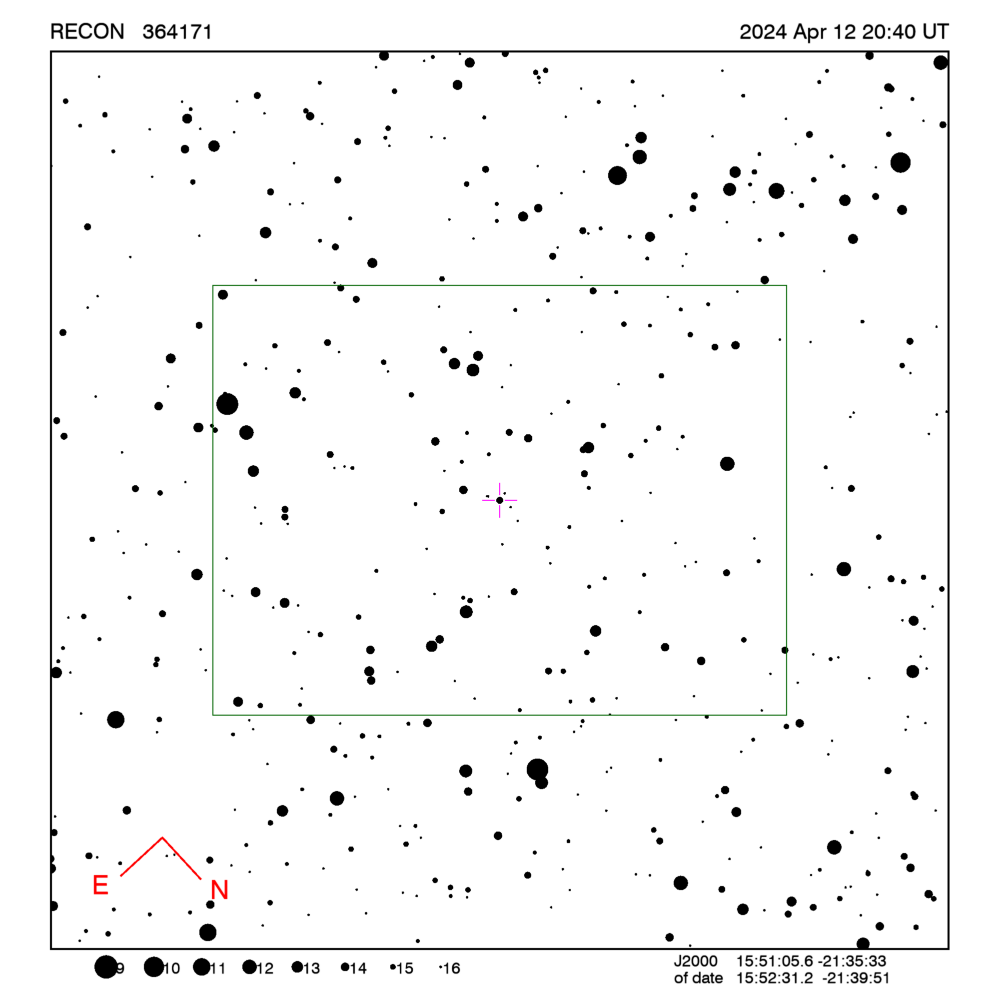RECON: TNO occultation with 364171
Event between (364171) 06JZ81 and star GA0680:06504048
with event index number of 2362500
Geocentric closest approach at 2024/04/12 20:40:14 UTC
J2000 position of star is 15:51:05.6 -21:35:33
Equinox of date position of star is 15:52:30.6 -21:39:49
Stellar brightness G=15.2,
use SENSEUP=128 with the MallinCam and and exposure
time of 2 seconds with the QHY174 camera.
Star is 162 degrees from the moon.
Moon is 21% illuminated.
Apparent brightness V=23.1
 Object is 41.3 AU from the Sun
and 40.5 AU from the Earth.
Object is 41.3 AU from the Sun
and 40.5 AU from the Earth.
Apparent velocity is 18.6
km/sec on the sky relative to the star, or,
2.3 arcsec/hr.
The 1-sigma error in the time of the event is 275 seconds.
The 1-sigma cross-track error in the shadow position is
2583 km.
The object has an absolute magnitude Hv=6.9
Diameter=252.4 km assuming a 5% albedo -- 13.6 sec chord
Diameter=103.0 km assuming a 30% albedo -- 5.5 sec chord
Dynamical classification is CLASSICAL
Star training set for 364171, (2024/04/12 20:40UT)
Object RA Dec mag sep mel
Antares 16:30:54.0 -26:29:02 0.9 9.99 172
7Del Sco 16:01:46.4 -22:41:20 2.3 2.37 164
45Lam Lib 15:54:44.9 -20:14:16 5.0 1.52 162
PPM 264743 15:51:22.1 -21:33:47 7.9 0.29 161
PPM 264793 15:53:34.8 -21:45:16 8.6 0.26 162
PPM 264744 15:51:24.5 -21:39:10 10.1 0.26 161
364171 15:52:31.2 -21:39:51 15.2 162
Positions are for equinox of date

Azimuth is measured in degrees eastward from north.
North is at an azimuth of 0, due East is at an azimuth
of 90 degrees, due South is 180, and due West is 270.
Do not use the listing below for the RECON CPC 1100 telescopes.
This is provided for other non-team facilities.
Star training set for 364171, (2024/04/12 20:40UT)
Object RA Dec mag sep mel
Antares 16:29:24.4 -26:25:56 0.9 9.99 172
7Del Sco 16:00:20.0 -22:37:19 2.3 2.37 164
45Lam Lib 15:53:20.0 -20:10:02 5.0 1.52 162
PPM 264743 15:49:56.6 -21:29:27 7.9 0.29 161
PPM 264793 15:52:09.1 -21:41:00 8.6 0.26 162
PPM 264744 15:49:58.9 -21:34:50 10.1 0.26 161
364171 15:51:05.6 -21:35:33 15.2 162
Positions are for J2000
Event circumstances last updated at 2024/02/12 04:19:59 UT
Marc W. Buie,
Southwest Research Institute
RECON
 Object is 41.3 AU from the Sun
and 40.5 AU from the Earth.
Object is 41.3 AU from the Sun
and 40.5 AU from the Earth.
